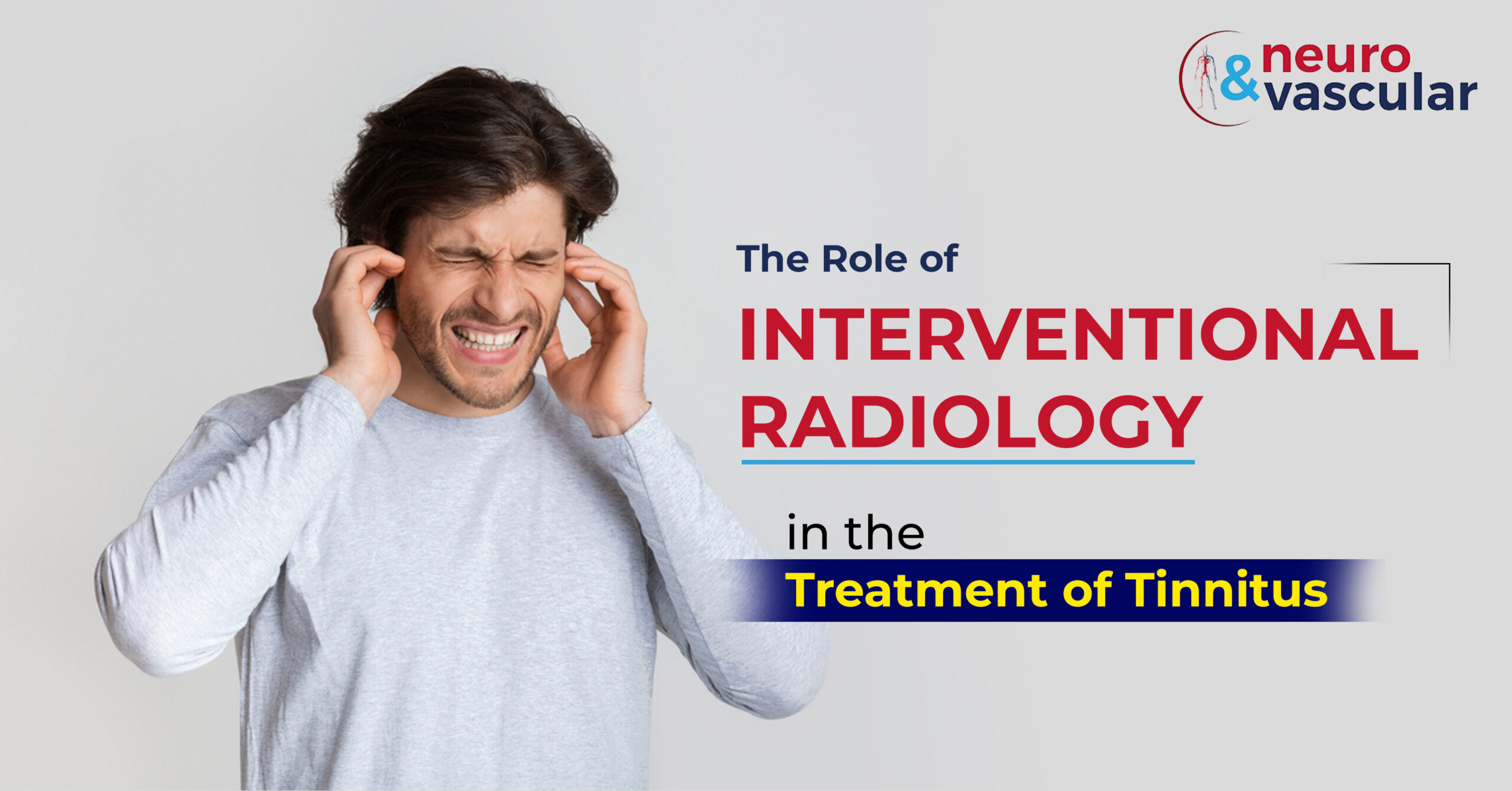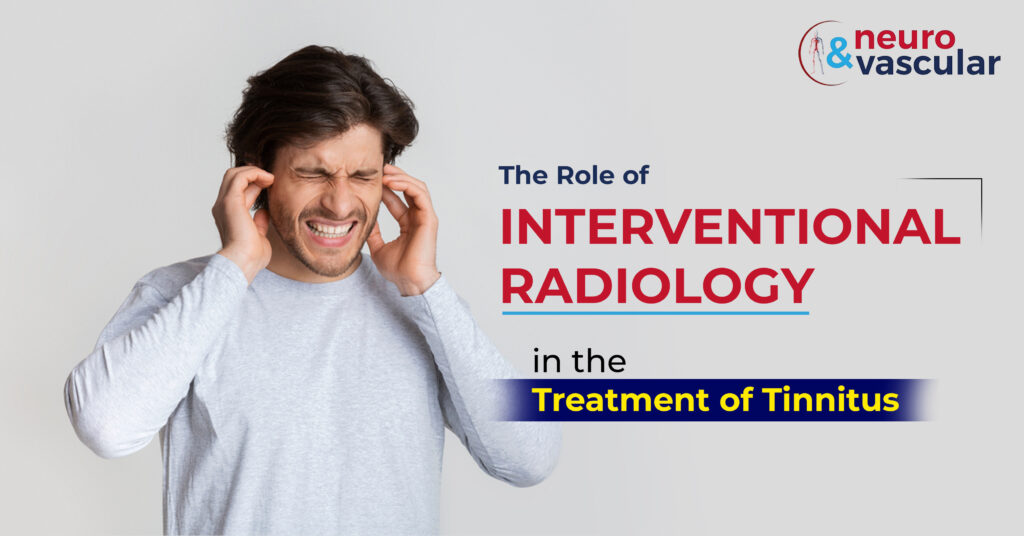
The Role of Interventional Radiology in the Treatment of Tinnitus

What is Tinnitus?
Tinnitus is a medical condition characterized by the perception of sound in one or both ears, even in the absence of any external sound source. Treatment of Tinnitus treated with Interventional radiology techniques. Tinnitus symptoms are The sound, which can be ringing, buzzing, whistling, hissing, humming, or even pulsating noise, is often described as annoying and distressing, and can significantly impact a person’s quality of life. It is called pulsatile if the sound is rhythmical and synchronous with the heartbeat, which means the timing and frequency of the sound coincide with that of the heartbeat.
What Causes Tinnitus?
Tinnitus can be caused by a variety of factors, including:
- Exposure to loud noise: Prolonged exposure to loud noises can damage the hair cells in the inner ear and cause tinnitus.
- Age-related hearing loss: As people age, the hair cells in the inner ear can naturally break down, leading to hearing loss and tinnitus.
- Head or neck injuries: Traumatic head or neck injuries can cause damage to the inner ear and lead to tinnitus.
- Ear infections: Infections in the middle or inner ear can cause inflammation and damage, leading to tinnitus.
- Neurovascular abnormalities: Abnormal blood flow or pressure in the brain blood vessels near the ear can cause tinnitus.
- Medications: Certain medications, such as aspirin, antibiotics, and chemotherapy drugs, can cause tinnitus as a side effect.
- Meniere’s disease: This inner ear disorder can cause tinnitus, vertigo, and hearing loss.
- Stress and anxiety: Chronic stress and anxiety can cause tinnitus or make existing tinnitus symptoms worse.

What are the symptoms of Tinnitus?
People with tinnitus will often complain of hearing these sounds in their head which may be ringing, roaring, buzzing or hissing in nature.
In addition to the perception of sounds in the ears, some people with tinnitus may experience the following symptoms:
- Difficulty hearing: Tinnitus can make it difficult to concentrate and hear other sounds.
- Sleep disturbances: Tinnitus can interfere with sleep, causing fatigue and decreased alertness during the day.
- Anxiety and depression: Tinnitus can cause stress, anxiety, and depression, which can further exacerbate the symptoms.
- Irritability and frustration: The constant presence of tinnitus can cause irritation and frustration, especially in quiet environments.
- Difficulty concentrating: Tinnitus can make it difficult to concentrate and remember things.

Diagnosis of Tinnitus:
- Physical Examination
- Hearing (audiogram) Test
- MRI or CT scan
Role of Interventional Radiology in the Treatment of Tinnitus:
Interventional radiology plays a crucial role in the treatment of tinnitus by offering minimally invasive, image-guided procedures to target the underlying causes of tinnitus, which may include the following-
- Idiopathic intracranial hypertension
- Cranial dural arteriovenous fistula
- Transverse/sigmoid sinus diverticulum
- Vertebro-jugular fistula
- Brain arteriovenous malformation
Although neurovascular causes of tinnitus are rare if it is found to be caused they can be definitively treated by interventional radiology treatments. The advantages of interventional radiology treatment of tinnitus are as follows
1. Precision: Interventional radiology allows for precise targeting of the specific parts of the body responsible for tinnitus, treatment of tinnitus reducing the risk of damaging surrounding healthy tissue.
2. Minimally invasive: Interventional radiology procedures are typically minimally invasive, requiring only small incisions or no incisions at all, and reducing the risk of complications and side effects compared to traditional surgery for the treatment of tinnitus.
3. Quick recovery time: Interventional radiology procedures often have a quicker recovery time compared to traditional surgery, and treatment of tinnitus allows patients to return to their normal activities sooner.
4. Effective results: Interventional radiology treatments for tinnitus have been shown to be effective in reducing or eliminating tinnitus symptoms in many patients.
Interventional Radiology Treatments used for Tinnitus:
In the treatment of tinnitus, interventional radiology plays a role in providing non-surgical treatment options to manage the symptoms.
The following are some of the interventional radiology treatments:
- Embolization for dural AVF or brain AVM: This procedure involves selectively blocking the blood flow to the blood vessels near the ear contributing to the AVF those are causing tinnitus. This can help to eliminate the symptoms without affecting normal circulation around the ear and brain.
- Venous sinus stenting for Idiopathic intracranial hypertension (IIH): In patients with venous sinus blocks near the ear, the blocks can create turbulence of blood flow near the ear, which can manifest as tinnitus. Opening these blocks with stents can ameliorate the turbulence as well as tinnitus.
- Coiling of venous sinus diverticulum: Coiling or closure of the diverticulum or aneurysm of the venous sinus can improve the symptoms.
It is important to note that these treatments may not be appropriate for everyone and their effectiveness may vary from person to person. It is important to consult an interventional radiologist or a specialist in the field to determine the best course of treatment for your specific needs.
Overall, interventional radiology is an important tool in the treatment of tinnitus, offering patients a minimally invasive, precise, and effective option. If you are suffering from tinnitus and are considering treatment options, be sure to discuss interventional radiology with Our Interventional radiologist. With the help of interventional radiology, it is possible to reduce the impact of tinnitus and improve your quality of life.
Frequently Asked Questions:
Q: Can other people hear my tinnitus?
A: There are very rare forms of tinnitus that can be heard from your ear canal. These are very soft sounds that others cannot hear unless they are listening at a very close distance or with the help of a microphone and an amplifier.
Q: What is Pulsatile Tinnitus?
A: Pulsatile tinnitus is a type of tinnitus that is associated with a rhythmical sound that is synchronous with the heartbeat. It is often caused by an underlying vascular condition, such as a blood vessel abnormality or a narrowed blood vessel.
Q: How successful is embolization for treating pulsatile tinnitus?
A: The success rate of embolization for treating pulsatile tinnitus varies depending on the underlying cause of the condition. However, it has been shown to be effective in a significant number of patients.
About the Author:

Name: DR . SURESH GIRAGANI
INTERVENTIONAL RADIOLOGIST
DR. SURESH GIRAGANI CONSULTANT INTERVENTIONAL RADIOLOGIST at Apollo hospitals Jubilee Hills, has more than sixteen years of clinical experience in vascular interventions with a special interest in neurovascular and peripheral vascular disease interventional procedures.